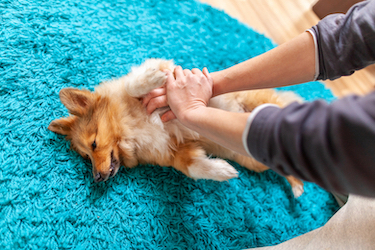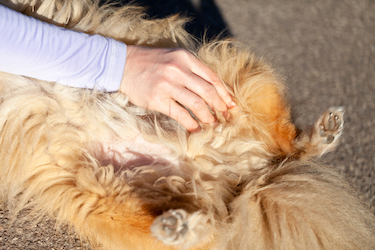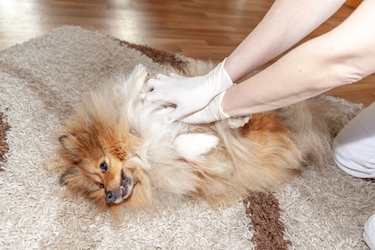CPR for Dogs: A 5-Step Guide
Posted: 05/03/2023 | BY: Erin Cain | Categories: Dog , Health problems , Pet care , Uncategorized
Learning dog cardiopulmonary resuscitation (CPR) is one of the most important things you can do for your pup. It’s a scary thought, but even the healthiest dog can experience a life-threatening emergency and need immediate medical attention. Knowing what to do in such an event could mean the difference between life and death for your canine companion. Here’s a 5-step guide on how to learn dog CPR training and first aid skills so that you’re prepared when emergencies happen.

What is CPR For Dogs?
It is not only people that sometimes require CPR as a lifesaving technique, our dogs may also become seriously ill and CPR is the only thing that will save their life. CPR involves chest compressions with or without artificial respiration. This technique should ONLY be used on dogs when they are no longer breathing and/or when you cannot hear or feel their heart beating.
We should mention that CPR should only be performed when absolutely necessary, as the technique can cause damage to your dog. CPR should never be performed on a healthy dog. It is usually only done in cases where a dog has sustained some form of trauma, is choking, or has been suffering from a fatal illness.
CPR success rates are quite low, even when the technique is performed in a veterinary hospital with trained staff. It is ideal if you could perform CPR while transporting your fur baby to the nearest emergency clinic.
Focus on remaining calm
It is always a good idea to prepare for the worst when caring for your furkid. In an emergency situation, panic can set in quickly, and you must stay calm so as not to overwhelm yourself or further distress your pup, even if you have done CPR before. It is critical to a dog’s well-being that her pet parent is calm and clear-headed in this type of scenario.
First, take a few deep breaths to calm yourself down. Focus on how the air feels as it fills up your stomach, and then slowly breathe out until there’s no air left. Continue this process for at least three breaths.
Second, be sure to focus on the tasks at hand. If there are bystanders who offer help in this time of crisis, give them a specific job. Ask them to find the nearby animal and veterinary professionals or get directions so you can call and let your veterinarian’s office know you and your dog will be there shortly.
How do you know if CPR is necessary?
This first aid for dogs is necessary if your pup satisfies these three states:
- When your dog is unresponsive
- When your pet stops breathing
- When you cannot feel your dog’s pulse or heartbeat
It’s important to know that pet CPR for dogs is not quite the same for humans. That’s why we’ve put together this handy 5-step guide so you can be prepared should you need to use CPR on your pup in the future.

5 Steps for CPR for Dogs
1. Start with the ABCs
It is vital to approach a canine with caution when an emergency occurs. Even if it appears that your pup is unresponsive, she may still be capable of biting out of instinctual fear or pain response when touched.
Your first step is to walk through the ABCs before beginning pet CPR:
(A) Airways
The airways are significant in keeping your dog alive. Anything that obstructs them, like vomit or foreign objects like sticks, is dangerous because they prevent oxygen from getting to the lungs. Extend the dog’s tongue to get a look at the back of the throat. If objects are there, clear them away, but be careful; sometimes dogs bite out of panic, even when unconscious, so proceed slowly and cautiously with care.
(B) Breathing
It is essential to know that your dog isn’t breathing before beginning pet CPR because it can be hazardous. Applying traditional chest compressions might do more harm than good if the pup you are trying to save has signs of life.
If your pup is not breathing, you can begin initial “mouth to snout” procedures. Seal the pup’s mouth and lips with one hand and hold it shut using firm pressure. Rapidly and forcefully exhale into the nose 4 to 5 times. Repeat if necessary.
(C) Circulation
The final step before beginning CPR is to check your dog’s pulse. You can generally tell if your pup has a pulse if you see the chest rising and falling. Animals do not have distinct carotid (neck) pulses, so determine the dog’s heartbeat location for more accurate results. As you never want to start CPR on a dog with a heartbeat, go through these steps first:
- Kneel beside your dog, placing one hand over her heart and another hand underneath her body.
- Check the femoral pulse inside your dog’s leg in the groin region.
- If there is no pulse, proceed to CPR compressions.

2. Determine CPR according to hand technique and dog size
Chest compression directions for canine sizes
The size of your dog will dictate the way she should lay on the ground before compressions begin.
If your canine is round-chested, found typically in Labrador Retrievers and Great Danes, place your hands over the highest point of the chest.
For narrow, deep-chested dogs and small canines, such as Dobermans and Corgis, place your hands over the dog’s heart. This location is where the dog’s elbow meets the chest.
Dogs who are flat-chested and who have squished faces, like English or French Bulldogs, need to be placed on their back for this step. Place your hands over your dog’s sternum.
3. Know proper hand techniques
If possible, use a two-handed approach to your compressions. Place one hand over the other, then place your shoulders directly over your hands.
Make sure your elbows are locked, and they do not bend.
Don’t lean over your pup. Instead, bend at your waist and use your core muscles to push down on your dog’s chest.
4. Begin chest compressions
Compressions are given at a rate of 100 to 120 per minute. It’s crucial after each push to pull back after each contraction and allow the chest to re-expand fully. This movement increases the CPR’s effectiveness.
For large canines, aim for hard compressions with a depth of 1/3 – 1/2 of the chest width. Perform 30 of these movements, then follow with 2 breaths of “mouth-to-snout” resuscitation. Again, make sure your dog’s mouth is tightly closed, keep the head and neck straight, then quickly exhale air 2 times into your dog’s nostrils.
To let CPR impact your dog’s body, perform at least 2-minute uninterrupted cycles.
5. Check ABCs and restart if necessary.
After 2 minutes of uninterrupted CPR, pause for a few seconds and walk through the ABCs again. If your dog is still in cardiopulmonary arrest, start another 2-minute CPR cycle immediately. However, if your pup has begun to spontaneously breathe again, showing any signs of consciousness, and has a heartbeat, stop CPR procedures. Take your pup to the nearest veterinary office or emergency clinic for stabilization and further treatment.
This video by Dr. Erica Tinson provides a visual overview of what correct CPR treatment for dogs should entail.
Be prepared to help your pup!
Life happens, and so do emergencies, but that doesn’t mean you have to be caught off guard if your pup needs emergency first aid. Consider enrolling in an online or local pet CPR class that offers pet CPR training and certification, so you can learn pet CPR and how to administer CPR. While you will hopefully never need to use CPR for your pup’s safety, if you ever do, you will be your dog’s best chance at survival. Practice makes perfect, so reach out to local organizations, shelters, and rescues to see if community courses are available.
Don’t forget to make sure your pup has pet health insurance. Emergency veterinary clinics come with costly vet bills, but with a dog pet insurance policy, up to 90% of those fees will be reimbursed to you. Pet Insurance Review will find the best health insurance policy for you and your furkid. Get your pup a free pet insurance quote right now!
References:
1. Becker, M. (2017). A Vet’s 5 Tips for Coping With a Pet Emergency. Retrieved from http://www.vetstreet.com/dr-marty-becker/a-vets-5-tips-for-coping-with-a-pet-emergency
2. Go Pet Friendly. (2020). How to Check Your Dog’s Pulse, Respiration, and Temperature. Retrieved from https://www.gopetfriendly.com/blog/how-to-check-your-dogs-pulse-respiration-and-temperature/
3. Smith, E. (n.d.). How to Take a Femoral Pulse in a Dog. Retrieved from https://pets.thenest.com/femoral-pulse-dog-4392.html
4. Tinson, E. (2021). Emergency Vet Instructs Learn to Perform CPR on a Dog in 5 Minutes. Retrieved from https://www.youtube.com/watch?v=AvfaqBiVLH0
5. American Red Cross. (2021). Cat & Dog First Aid Online Training. Retrieved from https://www.redcross.org/take-a-class/first-aid/cat-dog-first-aid
DisclaimerThe information contained on this blog is intended for informational and educational purposes only and should not be construed as medical advice. It is not a substitute for professional veterinary care. Always consult with your veterinarian before making any changes to your pet's health care or treatment plan.
The authors of this blog are not veterinarians and do not claim to be experts in pet health. The information provided here is based on our own experiences and research, as well as information from reputable sources. However, we cannot guarantee the accuracy or completeness of this information.
We encourage you to do your own research and consult with your veterinarian before making any decisions about your pet's health.
Previous post
Goldendoodle Health Issues: Pet Insurance is a MustCompare top pet insurance providers plans.
Enter your dog’s age in years and months to calculate their age equivalent to human years.
Calculate your dog’s ageEnter your cat’s age in years and months to calculate their age equivalent to human years.
Calculate your cat’s age